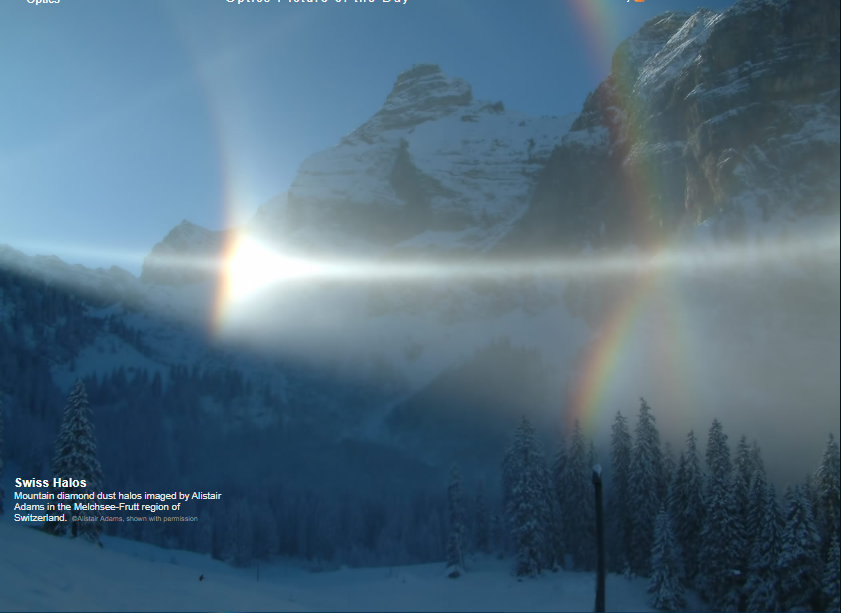OPOD - Swiss Halos
OPOD - Swiss Halos: A Spectacular Display of Atmospheric Optics
Switzerland is renowned for its breathtaking landscapes, and sometimes even the sky adds its own touch of magic. One such mesmerizing phenomenon is the display of halos observed in the Melchsee-Frutt region. Alistair Adams, an avid photographer, captured the beauty of mountain diamond dust halos in this picturesque location.
Unveiling the Splendor of Swiss Halos
The image showcases a stunning array of atmospheric optics phenomena. Let's delve into the details and uncover the hidden wonders within this captivating photograph.
-
Parhelic Circle: Stretching horizontally from the sun, just beyond the frame on the left side, a white parhelic circle steals the show. Its intense brightness almost transforms it into a solid bar. This circle is caused by sunlight reflecting off horizontally oriented ice crystals in the atmosphere.
-
Sundog: Adjacent to the parhelic circle, a blindingly bright sundog emerges. Created by sunlight refracting through horizontal ice plates, this phenomenon adds an ethereal touch to the scene.
-
22° Halo: Nestled within the sundog, an inclined 22° halo appears. This halo forms when sunlight passes through hexagonal ice crystals at a specific angle. Its presence enhances the celestial spectacle.
-
Helic Arc: Inside the 22° halo and inclined upwards, a rare helic arc from Parry-oriented crystals graces the sky. This arc is a result of sunlight interacting with unique ice crystal orientations.
-
Supralateral and Infralateral Arcs: On the right side of the image, horizontal column crystal supralateral and infralateral arcs intersect at a cusp near the parhelic circle. These arcs are formed by sunlight interacting with hexagonal ice columns in the atmosphere.
-
Parry Supralateral Arc: The supralateral arc at the top of the image exhibits a captivating brightening. This phenomenon is a rarer occurrence known as a Parry supralateral arc, adding an extra touch of uniqueness to the display.
-
Crystal Dispersion: The colors of these halos are widely spread due to the dispersion of light through crystal faces inclined at 90°, in contrast to the 60° inclination of halos closer to the sun. This dispersion creates a vibrant palette of hues, enhancing the visual spectacle.
-
Distinguishing Features: The cusp at the parhelic circle serves as a key distinguishing feature between supralateral/infralateral arcs and the rarer 46° halo. This distinction is crucial in identifying and understanding the various atmospheric optical phenomena at play.
-
Nature vs. Snow Blowers: While this display of halos is undeniably captivating, it is worth noting that the crystals responsible for this spectacle may not have been entirely natural. Crystals of exceptional optical quality often form downwind of nuclei emitted by snow blowers. Although a snow blower was operating approximately 5 km away, it remains uncertain whether it contributed to the crystal formation in this particular instance.
-
Awe-Inspiring Halo Display: The Swiss Halos captured in this photograph represent a pinnacle of halo displays. Despite the possibility of human influence, the sheer beauty and complexity of these atmospheric optical phenomena are truly awe-inspiring.
As we marvel at this extraordinary celestial spectacle, let us appreciate the intricate interplay between light and ice crystals that brings such ethereal beauty to our skies. The wonders of atmospheric optics never cease to amaze, reminding us of the vast complexity and elegance of our natural world.
Please note that this article has been automatically converted from the old site and may not appear as intended.

Swiss Halos
Mountain diamond dust halos imaged by Alistair Adams in the Melchsee-Frutt region of Switzerland. ©Alistair Adams, shown with permission

A white parhelic circle, almost a solid bar in intensity, sweeps horizontally from the sun off-image at left. At left is a blindingly bright sundog from horizontal plates and a weaker 22� halo.
Inside the 22� halo and inclined upwards is a rare helic arc from Parry oriented crystals.
At right, horizontal column crystal supralateral and infralateral arcs intersect in a cusp at the parhelic circle. The brightening of the supralateral arc at the picture�s top is a rarer Parry supralateral arc.
Halos are labelled in the 100 million ray HaloSim ray tracing at left.
The cusp at the parhelic circle is a sure way to distinguish supralateral/infralateral arcs from the rarer 46� halo. Colours of these halos are widely spread because the dispersion is through crystal faces inclined at 90� compared with the 60� of halos closer to the sun.
Halo displays do not come better than this. At the risk of slightly impairing the magic, the crystals might not have been entirely natural. Crystals of exceptional optical quality form slowly downwind of the nuclei emitted by snow blowers and one was operating about 5 km distant. However, we do not know whether it was a contributor.
Note: this article has been automatically converted from the old site and may not appear as intended. You can find the original article here.
Reference Atmospheric Optics
If you use any of the definitions, information, or data presented on Atmospheric Optics, please copy the link or reference below to properly credit us as the reference source. Thank you!
-
<a href="https://atoptics.co.uk/blog/opod-swiss-halos/">OPOD - Swiss Halos</a>
-
"OPOD - Swiss Halos". Atmospheric Optics. Accessed on November 21, 2024. https://atoptics.co.uk/blog/opod-swiss-halos/.
-
"OPOD - Swiss Halos". Atmospheric Optics, https://atoptics.co.uk/blog/opod-swiss-halos/. Accessed 21 November, 2024
-
OPOD - Swiss Halos. Atmospheric Optics. Retrieved from https://atoptics.co.uk/blog/opod-swiss-halos/.